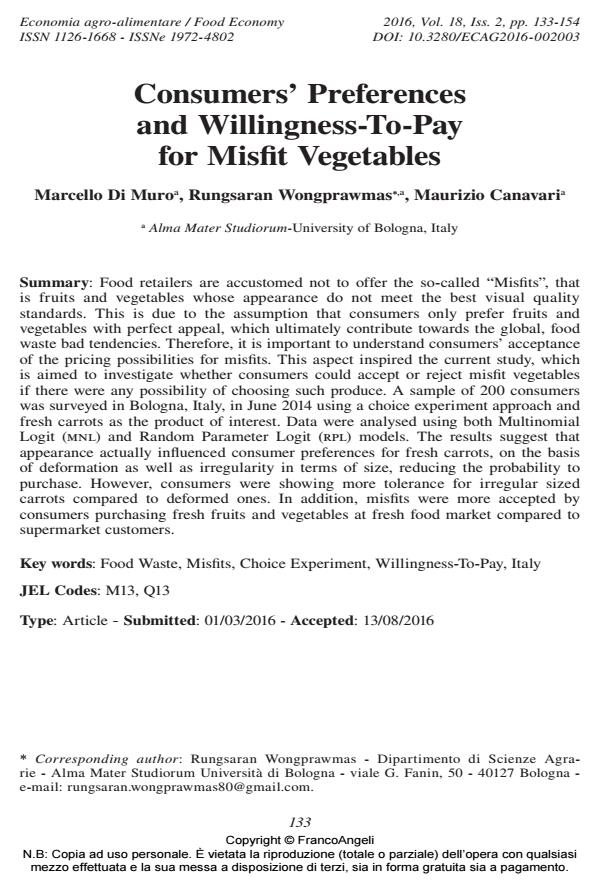Consumers’ Preferences and Willingness-To-Pay for Misfit Vegetables
Journal title ECONOMIA AGRO-ALIMENTARE
Author/s Marcello Di Muro, Rungsaran Wongprawmas, Maurizio Canavari
Publishing Year 2016 Issue 2016/2
Language English Pages 22 P. 133-154 File size 217 KB
DOI 10.3280/ECAG2016-002003
DOI is like a bar code for intellectual property: to have more infomation
click here
Below, you can see the article first page
If you want to buy this article in PDF format, you can do it, following the instructions to buy download credits

FrancoAngeli is member of Publishers International Linking Association, Inc (PILA), a not-for-profit association which run the CrossRef service enabling links to and from online scholarly content.
Food retailers are accustomed not to offer the so-called "Misfits", that is fruits and vegetables whose appearance do not meet the best visual quality standards. This is due to the assumption that consumers only prefer fruits and vegetables with perfect appeal, which ultimately contribute towards the global, food waste bad tendencies. Therefore, it is important to understand consumers’ acceptance of the pricing possibilities for misfits. This aspect inspired the current study, which is aimed to investigate whether consumers could accept or reject misfit vegetables if there were any possibility of choosing such produce. A sample of 200 consumers was surveyed in Bologna, Italy, in June 2014 using a choice experiment approach and fresh carrots as the product of interest. Data were analysed using both Multinomial Logit (mnl) and Random Parameter Logit (rpl) models. The results suggest that appearance actually influenced consumer preferences for fresh carrots, on the basis of deformation as well as irregularity in terms of size, reducing the probability to purchase. However, consumers were showing more tolerance for irregular sized carrots compared to deformed ones. In addition, misfits were more accepted by consumers purchasing fresh fruits and vegetables at fresh food market compared to supermarket customers.
Keywords: Food Waste, Misfits, Choice Experiment, Willingness-To-Pay, Italy
Jel codes: M13, Q13
- Making ugly food beautiful: Consumer barriers to purchase and marketing options for Suboptimal Food at retail level – A systematic review Theresa Hartmann, Benedikt Jahnke, Ulrich Hamm, in Food Quality and Preference 104179/2021 pp.104179
DOI: 10.1016/j.foodqual.2021.104179 - The Impacts of Food Waste Information on Consumer Preferences for Blemished Produce and Implications for Food Retailers Alba J. Collart, Matthew G. Interis, Chloe’ Henson, Josh Maples, in Journal of Agricultural and Applied Economics /2022 pp.440
DOI: 10.1017/aae.2022.21 - Current Developments in Biotechnology and Bioengineering C. Chroni, Katia Lasaridi, K. Abeliotis, T. Manios, pp.107 (ISBN:9780128191484)
- Does dietary knowledge affect household food waste in the developing economy of China? Shi Min, Xiaobing Wang, Xiaohua Yu, in Food Policy 101896/2021 pp.101896
DOI: 10.1016/j.foodpol.2020.101896 - Generation of food waste in the hospitality and food retail and wholesale sectors: lessons from developed economies Ali Chalak, Chaza Abou-Daher, Mohamad G. Abiad, in Food Security /2018 pp.1279
DOI: 10.1007/s12571-018-0841-0 - Perfect apples or sustainable production?—Consumer perspectives from Germany Ronja Hueppe, Katrin Zander, in Journal of Consumer Behaviour /2024 pp.698
DOI: 10.1002/cb.2236 - Influence of the involvement in food waste reduction on attitudes towards sustainable products containing seafood by-products Themistoklis Altintzoglou, Pirjo Honkanen, Ragnhild Dragøy Whitaker, in Journal of Cleaner Production 125487/2021 pp.125487
DOI: 10.1016/j.jclepro.2020.125487 - What are the ‘shape friendly’ locations to sell misshapen tomatoes? The effect of point of purchase on consumers’ abnormality perception and probability to buy Iris Vermeir, Dacinia Crina Petrescu, Ruxandra Malina Petrescu-Mag, in Food Quality and Preference 104809/2023 pp.104809
DOI: 10.1016/j.foodqual.2023.104809 - The role of diverse distribution channels in reducing food loss and waste: The case of the Cali tomato supply chain in Colombia Géraldine Chaboud, Paule Moustier, in Food Policy 101881/2021 pp.101881
DOI: 10.1016/j.foodpol.2020.101881
Marcello Di Muro, Rungsaran Wongprawmas, Maurizio Canavari, Consumers’ Preferences and Willingness-To-Pay for Misfit Vegetables in "ECONOMIA AGRO-ALIMENTARE" 2/2016, pp 133-154, DOI: 10.3280/ECAG2016-002003